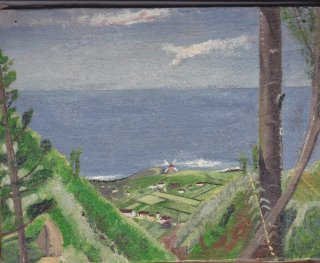Interessante que a pintura foi pintada na tampa de madeira de uma caixa de charutos americanos.
Outros quadros pequenos pintou-os também em madeira, até que se conseguiu tela.
Na sua juventude, foi aluno do Mestre Domiingos Rebelo
.
Painting made by my father, Gil Alves in 1946 when he worked at the PX at the American Base in Santa Maria, Azores. He signed his works with name SELVA, a play on the letters in the name Alves. It means, jungle in English. He continued to use this pseudo name with the remainder of the works he painted.
Interesting enough is the fact that the painting is made on the reverse side of the lid of an American cigar box and is visible in the photo below and exemplifies the shortages that occurred during WWII..In all of his small paintings, he continued to use wood, until canvas was available.
This painting is of Almagreira in the Island of Santa Maria, Azores. In his youth, he studied with the Master, Domingos Rebelo.
Outra pintura do meu pai, que não está assinada ou identificada, mas que imagino ser de por volta de 1939. É dos Mosteiros, onde ele ia visitar primos todos os anos durante as colheitas, por eles terem uma eira. Juntavam a família por essa altura e era um tal festejar.
Penso que pintura foi feita perto do Pico de Mafra e foi pintada em tela e depois pregada a um pedaço de criptómeria.
Ao fundo ve-se o que hoje é conhecido, penso eu, pelo Moinho Branco.
Another painting made by father, and which he did not sign, but I believe to be from around 1939, is the one below of the town of Mosteiros, in the island of São Miguel, Azores, where the family gathered every summer during harvest time at accousins home, where there was a tresher. The gathering was a time of much merryment.
The painting was made near the area of Pico de Mafra and was painted on canvas and later nailed to wood (criptoméria)
In the back ground the Moinho Branco as it is known today, is visible.
The painting was made near the area of Pico de Mafra and was painted on canvas and later nailed to wood (criptoméria)
In the back ground the Moinho Branco as it is known today, is visible.



4 comments:
zzzzz2018.8.12
canada goose jackets
christian louboutin outlet
ralph lauren outlet
jordan shoes
moncler online outlet
converse trainers
vibram fivefingers
christian louboutin shoes
golden goose sneakers
mulberry handbags
jinyi717
hermes belt
michael kors outlet
nike shoes outlet
canada goose outlet
ralph lauren polo
moncler outlet
coach handbags
christian louboutin outlet
coach outlet online
coach outlet
louboutin shoes
nhl jersey
true religion jeans outlet
birken stock
adidas shoes
christian louboutin
converse trainer
canada goose outlet
coach factory outlet
nike shoes
yeezy
yeezy shoes
paul george
lebron shoes
adidas yeezy boost 350 v2
balenciaga sneakers
supreme hoodie
supreme clothing
yeezy boost 350
off white jordan 1
Post a Comment